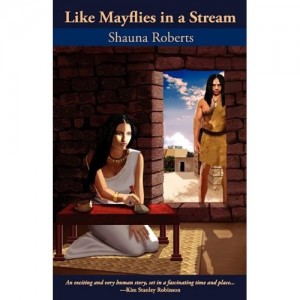Like Mayflies in a Stream
by Shauna Roberts (Hadley Rille Books, 2009) paperback, rrp £9.99
Reviewed by Rebecca Bowles Lawson
Shauna Roberts takes the reader on a rich and compelling journey to the ancient city of Uruk in Mesopotamia, approximately 4750 years ago. Said to be the greatest city of the ancient world, and encircled by a huge wall, it held around 80,000 inhabitants and covered two square miles. At the centre stood temples to An and Inanna, and until Imperial Rome nothing could match it for scale or grandeur.
 Like Mayflies in a Stream is fast-paced, crisp and vivid from the outset, depicting events, characters and scenes (particularly battle scenes) with a visceral and almost cinematographic style. It is also an historically-based work of fiction, well-researched by a writer who trained extensively as an anthropologist. Roberts weaves in Mesopotamian words to add authenticity and describes the society’s cultural customs, for example a religious fertility rite involving the re-enactment of ‘Sacred Marriage’ between a priestess of Inanna and the King.
Like Mayflies in a Stream is fast-paced, crisp and vivid from the outset, depicting events, characters and scenes (particularly battle scenes) with a visceral and almost cinematographic style. It is also an historically-based work of fiction, well-researched by a writer who trained extensively as an anthropologist. Roberts weaves in Mesopotamian words to add authenticity and describes the society’s cultural customs, for example a religious fertility rite involving the re-enactment of ‘Sacred Marriage’ between a priestess of Inanna and the King.
The novel unfolds against the backdrop of personal and political turmoil for the troubled citizens of Uruk who are subject to the unjust and cruel King Gilgamesh. His constant desire for power and acquisition—whether that be women, riches, or glory—leads him to commit terrible atrocities. Ultimately, Gilgamesh’s inner void and despair causes him to dream of finding a soul mate, ‘brother’ or ‘second self’- to which end he enlists the aid of temple priestess Shamhat. Shamhat is a strong female character, constantly battling to exert her own self under the yoke of various male influences; she is the central character of the novel and, to all intents and purposes, acts as the reader’s guide around Uruk.
Roberts creates an array of colourful characters, ranging from the High (En) Priest to Zaidu the Trapper, and from Enkidu the Wildman (who was all but brought up by gazelles) to Geshtu and his tragic young wife Nameshda. Despite the entertaining narrative, Like Mayflies in a Stream is based on historical scholarship that encompasses the greater cultural landscape of Sumer and its people’s lifestyles. In particular, the novel addresses the difficulties facing women – for example their attempt to control their own fertility and their efforts to achieve respect in spite of their sex. Whether they were royalty, priestesses or—most likely—just ordinary women, none are able to escape fully the confines of their gender.
I thoroughly enjoyed this book and became drawn into its world; it’s a rattling good yarn with characters we care for in situations that make us feel for them. Recommended for anyone interested in the ancient world and goddess-centred religions, or in novels that address social inequality by presenting the stories of individuals of varying status, class and rank.










Leave a Reply